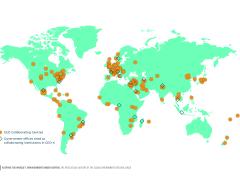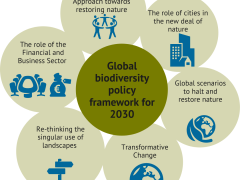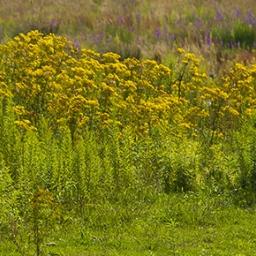Chronic Land Degradation: UN Offers stark warnings and practical remedies in Global Land Outlook 2
According to the Global Land Outlook 2 up to 40 % of the planet’s land is degraded which directly affects half of humanity and threatens roughly half of global GDP (USD 44 trillion). If business as usual continued through 2050, the report projects additional degradation of an area the size of South America. Nations’ current pledges to restore 1 billion degraded hectares by 2030 requires USD 1.6 trillion this decade — a fraction of the annual USD 700 billion in fossil fuel and agricultural subsidies. The UN offers a stark warning and practical remedies. For this report, PBL Netherlands Environmental Assessment Agency has provided a major contribution in the form of a scenario analysis, a cost-benefit analysis of restoration measures and an assessment of countries’ restoration commitments.
The way land resources — soil, water and biodiversity — are currently mismanaged and misused threatens the health and continued survival of many species on Earth, including our own, warns this new stark report from the United Nations Convention to Combat Desertification (UNCCD). It also points decision makers to hundreds of practical ways to restore local, national and regional land and ecosystems.
UNCCD’s evidence-based flagship Global Land Outlook 2 (GLO2) report, five years in development with 21 partner organisations, including PBL Netherlands Environmental Assessment Agency, offers an overview of unprecedented breadth. PBL’s analysis projects the consequences of three scenarios through 2050: business as usual, restoration of 50 million square km of land, and restoration measures augmented by the conservation of nature areas important for specific ecosystem functions.
Future scenarios
The report’s three scenarios project outcomes by 2050 and the risks involved:
1. Baseline scenario: Business as usual, continuing current trends in land and natural resource degradation, while the demand for food, feed, fibre, and bioenergy continues to rise. Land management practices and climate change continue to cause widespread soil erosion, declining fertility and growth in yields, and the further loss of natural areas due to expanding agriculture.
By 2050:
• Sixteen million square kilometres (the size of South America) show continued land degradation
• A persistent, long-term decline in vegetative productivity is observed for 12% to 14% of agricultural, pasture and grazing land and nature areas — with sub-Saharan Africa being the worst affected region.
• Land-use change and soil degradation will cause an additional 69 gigatonnes in carbon emissions between 2015 and 2050. This represents 17% of current annual greenhouse gas emissions: soil organic carbon (32 gigatonnes), vegetation (27 gigatonnes), peatland degradation/conversion (10 gigatonnes).
2. Restoration scenario: This scenario assumes the restoration of around 5 billion hectares (50 million square kilometres or 35% of the global land area) using measures such as agroforestry, grazing management, and assisted natural regeneration. (Current international pledges: 10 million square kilometres).
By 2050:
• Crop yields will increase by 5% to 10% in most developing countries, compared to the baseline. Improved soil health leads to higher crop yields, with the largest gains in the Middle East and Northern Africa, Latin America, and sub-Saharan Africa, limiting food price increases.
• Soil water holding capacity of rainfed croplands will increase by 4%.
• Carbon stocks will increase by a net 17 gigatonnes, between 2015 and 2050, due to gains in soil carbon and reduced emissions.
• Biodiversity will continue to decline, but not as quickly, with 11% of biodiversity loss averted.
3. Restoration and Protection scenario: This scenario includes the restoration measures, augmented with protection measures of areas important for biodiversity, water regulation, conservation of soil and carbon stocks, and provision of critical ecosystem functions.
By 2050:
• There will be an additional 4 million square kilometres of nature areas (the size of India and Pakistan); largest gains expected in South and Southeast Asia and Latin America. Protection measures will prevent land degradation caused by logging, burning, draining, or conversion.
• About a third of the biodiversity loss projected in the baseline would be prevented.
• An additional 83 gigatonnes of carbon will be stored, compared to the baseline. Avoided emissions and increased carbon storage will be equivalent to more than seven years of total current global emissions.
Good practice snapshots
GLO2 offers hundreds of good practice snapshots from around the world that illustrate context-specific measures to combat environmental degradation, restore land health, and improve living conditions. This includes many regenerative agricultural practices that have the potential to increase crop yields and improve their nutritional quality while reducing greenhouse gas emissions and drawing down carbon from the atmosphere. The case studies from around the world showcased in GLO2 make clear that land restoration can be implemented in almost all settings and at many spatial scales, suggesting that every country can design and implement a tailored land restoration agenda to meet their development needs.
- LinkTo the report on the Global Land Outlook website
- Rapport | 4 June 2021To the report The global potential for land restoration scenarios
- Rapport | 3 November 2020To the report Goals and commitments for the restoration decade
- LinkTo the Nature based solutions website




